Re-examining the role of cannabis through architecture in the Cannabis Bank competition
By Justine Testado|
Wednesday, Jul 27, 2016

Related
How can architecture explore the significant yet historically controversial role that cannabis has in modern-day society? What would be the ideal architectural typology for the multiple reasons why people consume cannabis? Architects around the globe addressed that notion in Bee Breeders' Cannabis Bank ideas competition. Imagining the possibilities are seemingly endless. However, challenges come into play when considering the various laws and political climates of cities worldwide, as well as people's individual viewpoints on cannabis.
The jury was drawn to submissions that fulfilled several criteria, including: presenting an innovative architectural typology with a compelling, cohesive argument regarding the correlated issues of cannabis; and sensitive accommodation of private and social spaces that consider users' very individual experiences in using the plant.
At the end of the competition, the jury picked three prize winners. Check them out below.
1ST PLACE: “U-CAN” by I-Ting Chuang, Yu Han Wu, Takanori Kodama Jing-Yao Lin | Taiwan | University: National Taiwan University of Science and Technology
RELATED COMPETITION Cannabis Bank
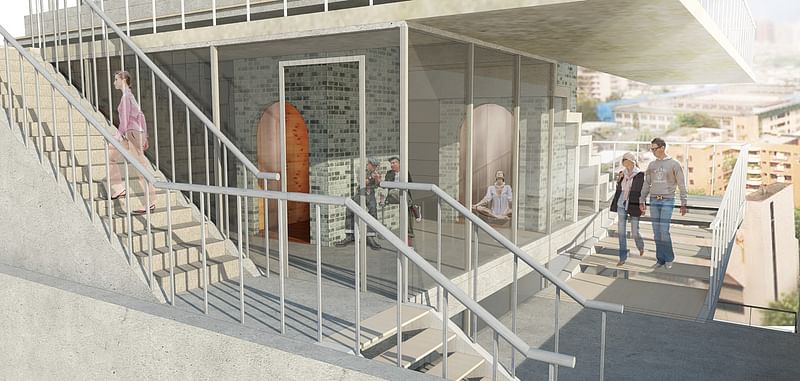

Project description: “U-CAN places the Cannabis dispensary on roof additions typical in cities of Taiwan. Although illegal, these roof additions have traditionally been permitted by Taiwanese authorities and are commonly used as places of household ancestral worship as well as shared social space. By associating the Cannabis dispensary with this explicitly illegal yet implicitly condoned urban fabric, U-CAN acknowledges the political paradoxes of a substance that is simultaneously illicit and sanctioned, recognizing Cannabis as a cultural artifact rather than just a prohibited product.
U-CAN navigates these ambiguities spatially, embedding both the public and private spaces of a Cannabis dispensary into an unsanctioned urban fabric. The proposal envelopes the intimate program of private consultation rooms within the more public visitor and commerce areas. These private rooms are expressed as light chimneys on the roof, creating a public gathering space that reaffirms Cannabis use as a fundamentally social and spiritual transaction. The U-CAN proposal successfully plays these political and social ambiguities against one another through this collective inhabitation of the roof, a space that is unsanctioned, marginal, forbidden, and yet a fundamental part of a shared urban identity.”
More info here.
2ND PLACE: “Cannaleonic Bank” by Héctor Duràn, Albert Pla, Joan Pau Albertì | Spain

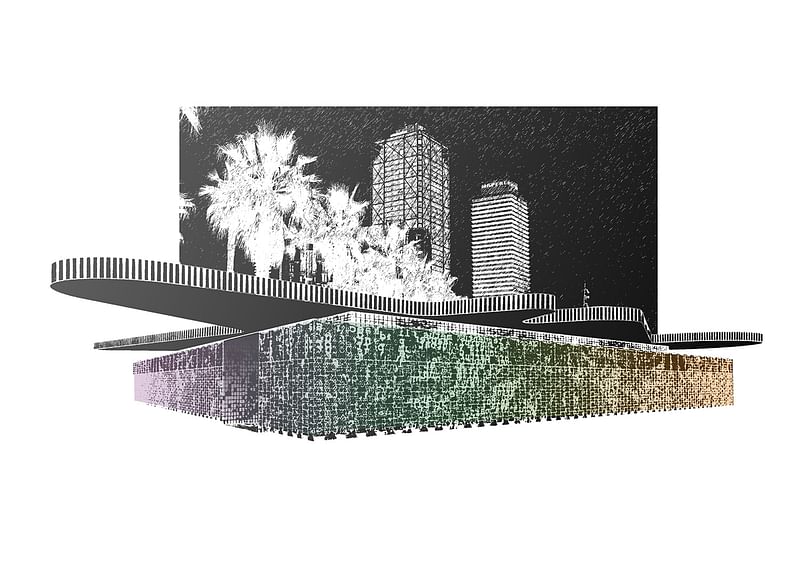
Project description: “The second place proposal is successful in its interpretation of the local politics surrounding Cannabis use, combined with clever architectural language to communicate a clear concept that is both iconic and versatile. The proposal is strategically sited in the medical research park in Barcelona, Spain, adjacent to the beach, symbolically representing both the dichotomy of public perception surrounding medicinal and recreational Cannabis use. Formally, the project is composed of a square boundary wall made up of informational pamphlets delineating the public from private. This ephemeral boundary literally degrades and morphs as people consume information, slowly revealing the project’s interior.
Beyond this ephemeral skin, the program is hosted in a series of rectilinear volumes loosely formed around a central courtyard open to the sky. This interior space, based on a simple column grid, is simultaneously intimate and social, both functional and mutable depending on the needs of a particular locale. Floating above this interior, the roof comprises the iconicity of the project: a flat horizontal datum laden and overflowing with plantings. The curvilinear contrast of the roof to the volumes beneath draws the eye to a recognizable silhouette and creates shaded public space.”
More info here.
3RD PLACE: “Cannabis River Cruise” by Sheehan Wachter, Cruz Crawford | United States | Company: Uburo Design

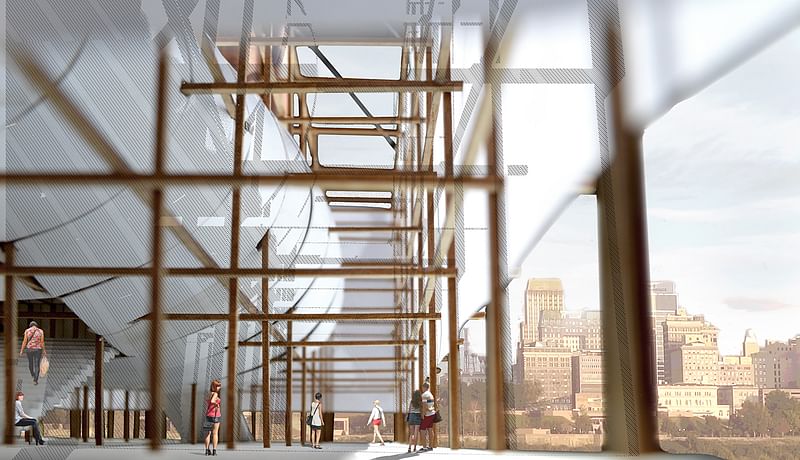
Project description: “The third place proposal astutely associates the steam boat as an architectural typology to house the Cannabis dispensary. Historically, steamboats played a major role in the advancement of American society, carrying goods and passengers up and down the Mississippi River. As a major form of transportation, the architecture of passenger steamboats adapted an extravagance of great halls, colonnades, and class, serving as a form of promenade for prominent individuals. Through adaption of architectural and technological form, the Cannabis River-Cruise implies a level of etiquette and societal progression to the culture of Cannabis. The project makes a bold statement that the societal view of Cannabis is evolving from transgression to prestige.
The architecture of the Cannabis River-Cruise relates back to the historic model of the steam boat through stratification of program and use of archetypes. The more utilitarian and private programs are purposefully located on the lower enclosed deck, allowing the spatial and explorative programs to be elevated. As in historic steamboats, the upper deck allows users to meander between colonnades on an elevated platform to see and be seen by passing shorelines. The great hall, designed as a cocoon behind a white veil, floats above the upper deck creating an intimate and other worldly meditative space for the use of medicinal Cannabis. The white veil with smoke stacks rising skyward acts as an architectural signifier to onlookers from shorelines passing by as the ship freely moves north to south, transcending cultural and political boundaries.”
More info here.
All images courtesy of Bee Breeders.
Find more images of each winning entry in the gallery below.

RELATED NEWS Winners of the Charlie Hebdo Portable Pavilion competition challenge conventions of free speech in contemporary society

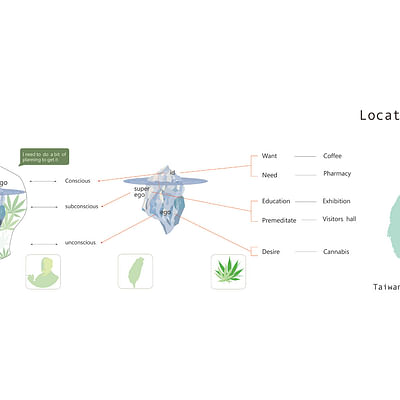
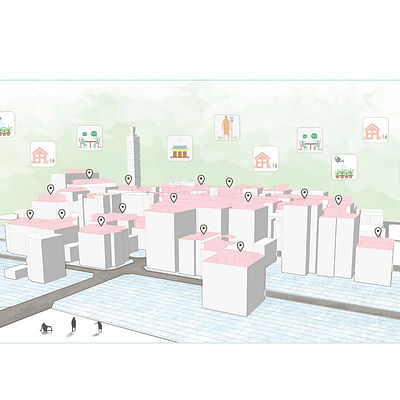




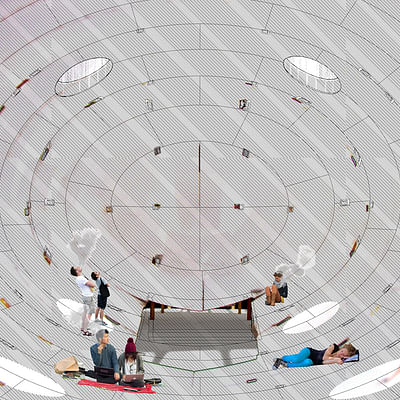

Share
0 Comments
Comment as :